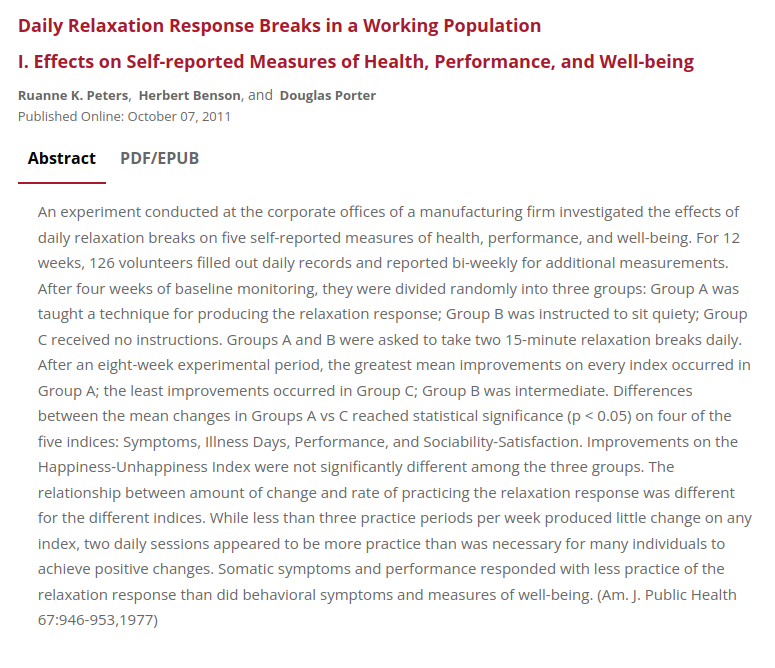An experiment conducted at the corporate offices of a manufacturing firm investigated the effects of daily relaxation breaks on five self-reported measures of health, performance, and well-being. For 12 weeks, 126 volunteers filled out daily records and reported bi-weekly for additional measurements. After four weeks of baseline monitoring, they were divided randomly into three groups: Group A was taught a technique for producing the relaxation response; Group B was instructed to sit quiety; Group C received no instructions. Groups A and B were asked to take two 15-minute relaxation breaks daily. After an eight-week experimental period, the greatest mean improvements on every index occurred in Group A; the least improvements occurred in Group C; Group B was intermediate. Differences between the mean changes in Groups A vs C reached statistical significance (p < 0.05) on four of the five indices: Symptoms, Illness Days, Performance, and Sociability-Satisfaction. Improvements on the Happiness-Unhappiness Index were not significantly different among the three groups. The relationship between amount of change and rate of practicing the relaxation response was different for the different indices. While less than three practice periods per week produced little change on any index, two daily sessions appeared to be more practice than was necessary for many individuals to achieve positive changes. Somatic symptoms and performance responded with less practice of the relaxation response than did behavioral symptoms and measures of well-being.
Daily Relaxation Response Breaks in a Working Population I. Effects on Self-reported Measures of Health, Performance, and Well-being
Publication
Am. J. Public Health
67:946-953
Abstract
Web and Email Links
Related Listings
Journal
Journal of Human Stress
Oxygen consumption is usually considered to be predictable and unalterable at a fixed work intensity. The relaxation response is hypothesized to be an integrated hypothalamic response which results in generalized decreased sympathetic nervous system activity. One physiologic manifestation of the relaxation response is decreased oxygen consumption. The possibility that the elicitation of the relaxation response could decrease oxygen consumption at a fixed work intensity was investigate […]
Journal
Behavior Research and Therapy
The theoretical basis of systematic desensitization is reciprocal inhibition in which an alternative, competitive response to anxiety is conditioned to arousal-producing, phobic stimuli. Abbreviated training in progressive relaxation is believed to serve as a competitive response to anxiety by decreasing autonomic nervous system activity. However, physiologic studies of progressive relaxation have not substantiated that its practice is associated with such decreased autonomic activity […]
Journal
American Journal of Physiology
Mental states can markedly alter physiologic function. Hypermetabolic physiologic states, with an increased oxygen consumption, accompany anticipated stressful situations. Hypometabolic physiologic changes, other than those occurring during sleep and hibernation, are more difficult to produce. The present investigation describes hypometabolic and other physiologic correlates of a specific technique of meditation know as "transcendental meditation". Thirty-six subjects were studied, ea […]

